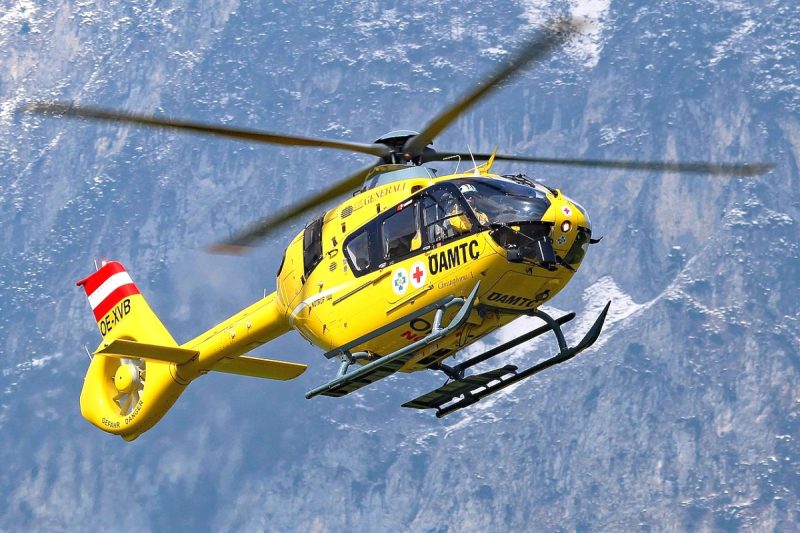In air rescue, visibility conditions are often crucial: in dense fog, an emergency medical helicopter cannot take off or land. In the past, dense fog has delayed or even prevented life-saving operations, particularly in the Klagenfurt Basin. For ten years now, Christophorus 11 has been able to take off even in poor visibility using the latest technology. A special fog-piercing procedure is used, which allows operations even in weather situations that are below the minimum values necessary for visual flight.
“Even if visibility on the ground is very poor, this instrument flight procedure enables safe take-offs and landings,” explains Marco Trefanitz, managing director of the ÖAMTC air rescue. “This has already made a difference in over 300 missions by allowing our crews to get to patients quickly and safely despite unfavorable conditions.”
C11 – Investment in state-of-the-art and cost-effective helicopters
To make this possible, investments have been made in recent years, among other things, in state-of-the-art, cost-efficient helicopters with four-axis autopilots. This technology supports complex missions with flight-related tasks including hovering, thereby relieving the pilots' workload. “Saving lives is our mission – but for us this also includes keeping our eyes focused on the future, thinking ahead and learning from experience in order to develop innovative solutions for our patients,” says Trefanitz. “The smoke penetration process has not only generally increased safety, but has also significantly increased the number of possible operations. In combination with the extended service hours that we have had here at C2018 since 11, people can be helped even more efficiently.” Since 2001, Christophorus 11 in Carinthia has been providing rapid and professional help from the air in the event of an emergency. More than 26.000 missions flown make it an essential part of nationwide emergency rescue.
“The 'air rescuers' take off in Carinthia around 3.000 times a year: Carinthia is very well positioned with three emergency medical helicopter bases or five over the winter months. The emergency doctors can be at the respective location within a few minutes. And this has been happening for ten years with the ÖAMTC helicopter Christophorus 11 from Klagenfurt, even in fog,” said health officer LR.in Beate Prettner, impressed by the procedure. According to Prettner, the importance of air rescue is increasing rapidly. “The reason for this is not least an increase in alpine accidents and accidents in impassable terrain. But also every other type of emergency operation where every second counts in the truest sense of the word. Here the Christophorus crews are indispensable for emergency medical care in Carinthia,” emphasized Prettner. “In addition to the optimal framework conditions, which we as a country are happy to ensure, we also need the will to continuously develop the system. This tireless commitment from those responsible makes it possible to respond more quickly to emergencies and save lives – 365 days a year.”
It is a matter of course for the ÖAMTC to constantly develop air rescue in order to be able to offer patients the highest quality and safety in all areas. “The smoke-piercing procedure is an outstanding example of how air rescue is expanding its boundaries to help people in need,” adds Johanna Mutzl, President of the ÖAMTC-Carinthia. “This can only be achieved with reliable partners like the state of Carinthia, which actively supports such projects at all times - because saving lives is teamwork!”
40 years of ÖAMTC air rescue with 435.000 missions across the country
This year the ÖAMTC air rescue emergency helicopters are celebrating their 40th birthday. But what is now an integral part of a modern healthcare system was originally anything but self-evident. In 1983, it took no more than three months to turn a vague idea into stationing an emergency medical helicopter. On July 1, 1983, Christophorus 1 took off from Innsbruck and Christophorus 2 was to follow from Krems in the same year. After four decades of air rescue, 435.000 missions as well as hundreds of employees in the air and on the ground, a state-of-the-art fleet and countless lives saved speak for themselves. Air rescue is now alerted over 20.000 times a year.
About the ÖAMTC air rescue
In emergency rescue, every minute counts. With 17 emergency medical helicopters, the ÖAMTC air rescue is in operation 365 days a year as an indispensable and versatile part of the health system for the Austrian population. No matter whether it is a heart attack, stroke, traffic accident or premature birth, whether in mountainous terrain or densely populated regions - the ÖAMTC air rescue helicopters bring the latest medicine and highly qualified emergency doctors and air rescuers directly to the patients. An intensive care transport helicopter and four seasonally operated winter bases complete the Christophorus fleet. In addition, the ÖAMTC air rescue is constantly working to further develop lifesaving from the air through innovative and modern solutions.







 trail (for them it's free to use)
trail (for them it's free to use)